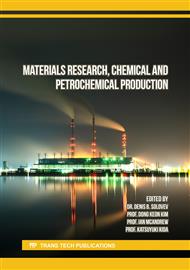[1]
P. Charnkeitking and S. Sripiboon: Key Eng. Mater., Vol.888, (2021), p.99.
Google Scholar
[2]
A. Kara, E. Demirbel, N. Tekin, B. Osman and N. Beşirli: J. Hazad. Mater., Vol.286 (2015) p.612.
Google Scholar
[3]
H. Peng, and J. Guo: Environ Chem Lett., Vol.18 (2020), p.2055.
Google Scholar
[4]
L.C. Flint, M.S. Arias-Paić and J.A. Korak: Environ. Sci. Water Res. Technol., Vol.7 (2021), p.2397.
Google Scholar
[5]
R.Saha, K. Mukherjee, I. Saha, A. Ghosh, S. K. Ghosh, and B. Saha: Res. Chem. Intermed., Vol.39 (2013), p.2245.
DOI: 10.1007/s11164-012-0754-z
Google Scholar
[6]
M. Ahmadi, E. Kouhgardi, and B. Ramavandi: Korean J. Chem. Eng., Vol.33, (2016), p.2589.
Google Scholar
[7]
I. Enniya, L. Rghioui, and A. Jourani: Sustainable Chem. Pharm., Vol.7, (2018), p.9.
Google Scholar
[8]
V. P. Dinh, H. Le, V.D. Nguyen, V. A. Dao, N.Q. Hung, L.A. Tuyen and L.V. Tan: RSC advances, Vol.9, (2019), p.25847.
Google Scholar
[9]
Ma, H., Yang, J., Gao, X., Liu, Z., Liu, X., and Xu, Z.: J. Hazad. Mater., Vol.369, (2019), p.550.
Google Scholar
[10]
A.A. Aryee, E. Dovi, Q. Li, R. Han, Z. Li, and L. Qu: Chemosphere, Vol.287, (2022), p.132030.
Google Scholar
[11]
Ali, A., Saeed, K., & Mabood, F.: Alexandria Eng. J., Vol.55, (2016), p.2933.
Google Scholar
[12]
Wu, Y., Cha, L., Fan, Y., Fang, P., Ming, Z., Sha, H., Water Air Soil Pollut., Vol.228, (2017), p.1.
Google Scholar
[13]
Y. Yi, J. Lv, Y. Liu, and G. Wu: J. Mol. Liq., Vol.225, (2017), p.28.
Google Scholar
[14]
Z. Yin, S. Xu, S. Liu, S., Xu, J. Li, and Y. Zhang: Bioresour. Technol., Vol.300, (2020), p.122680.
Google Scholar
[15]
E. Vunain, J.B. Njewa, T.T. Biswick, and A.K. Ipadeola: Appl. Water Sci., Vol.11 (2021), p.1.
Google Scholar
[16]
J. Yang, J. B. Huang and M. Lin: J. Chem. Eng. Data, Vol.65, No.5, (2020), p.2751.
Google Scholar
[17]
M.T. Sikder, T. Kikuchi, J. Suzuki, T. Hosokawa, T. Saito: Sep. Sci. Technol., Vol.48, (2012), p.587.
Google Scholar
[18]
T.J. Buran, A.K. Sandhu, Z. Li, C.R. Rock, W.W. Yang, L. J. Gu: Food Eng.,Vol.128, (2014), p.167.
Google Scholar
[19]
M. Manjuladevil and S. Manonmani: Orient. J. Chem., Vol.31, (2015), p.531.
Google Scholar
[20]
M.H. Dehghani, D. Sanaei, I. Ali and A. Bhatnagard: J. Mol. Liq., Vol.215, (2016), p.671.
Google Scholar
[21]
S.M. SamuelAbigail, and R. Chidambaram: PLoS One, Vol.10, No.3, (2015), p.e0116884.
Google Scholar
[22]
S. Rangabhashiyam, N. Selvaraju, B.R. Mohan, P.M. Anzil, K. Amith and E. Ushakumary: J. Environ. Eng., (2015), 10.1061/(ASCE)EE.1943-7870.0 000988
DOI: 10.1061/(asce)ee.1943-7870.0000988
Google Scholar
[23]
J. Kumari, D-R H. Krishnamoorthy and T.K Arumugam: J. Mater. Environ. Sci., Vol.6 (2015) p.1532.
Google Scholar
[24]
M. Suneetha, B.S. Sundar, K. Ravindhranath: J. Anal. Sci. Technol.Vol.6, (2016), p.15.
Google Scholar



